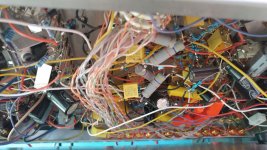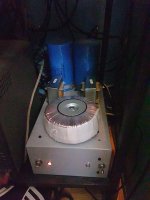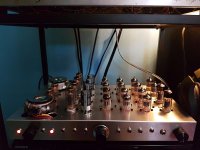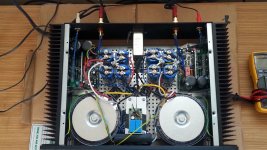I was expecting to be successful searching on the subject, but found nothing here, AA, or Google. The only thread was short lived, and provided advice to use coax (which doesn't excite me).
So, what has experience shown us with input/output wiring to RCA's? Is twisted pair sufficient, or is shielded recommended? If we are able to neglect the effects of capacitance, it would seem to me shielded would be best.
On the one hand, a low impedance source should have no problem driving a little extra shielded wire; so we should be able to use shielded for output wiring. However, it can also be argued that a low impedance source is not susceptible to induced pickup, so twisted pair would be fine.
With inputs, I see a better case for shielded, as the nodes are typically of higher impedance, therefore more likely to pickup noise. As long as the additional capacitance won't adversely affect our FR, I would think shielded is the way to go.
I ask because of course I'm in the middle of a preamp, but also most of the pictures I have seen of DIY projects use twisted pair.
So, what has experience shown us with input/output wiring to RCA's? Is twisted pair sufficient, or is shielded recommended? If we are able to neglect the effects of capacitance, it would seem to me shielded would be best.
On the one hand, a low impedance source should have no problem driving a little extra shielded wire; so we should be able to use shielded for output wiring. However, it can also be argued that a low impedance source is not susceptible to induced pickup, so twisted pair would be fine.
With inputs, I see a better case for shielded, as the nodes are typically of higher impedance, therefore more likely to pickup noise. As long as the additional capacitance won't adversely affect our FR, I would think shielded is the way to go.
I ask because of course I'm in the middle of a preamp, but also most of the pictures I have seen of DIY projects use twisted pair.
If you use manual rotary controls move them to the rear of the enclosure to cut the cable wiring, and operate them with extension rods to the front panel. There is usually no good reason for mounting the input selector switch through the front panel. People do it like sheep follow each-other.
Switch both signal and signal return at your input. Ignore those who call signal return "ground".
Consider co-axial cable for your pre-amplifier internal wiring for inputs and outputs.
Switch both signal and signal return at your input. Ignore those who call signal return "ground".
Consider co-axial cable for your pre-amplifier internal wiring for inputs and outputs.
Twisted pairs work fine inside enclosures and may be somewhat more effective where magnetic fields are present as opposed to electro-static fields. Coax is more effective in the presence of electro-static fields where the primary coupling mechanism is capacitive.
I frequently use twisted, shielded pairs in noisy environments, best of both worlds..
Personally I like to avoid coax when possible due to the additional capacitance and the sometimes not so good d/a of cheap coax insulation. Not all of my sources (tube anyway) have very low output z.
The suggestion to move the source select switch close to the inputs is a very good one. I have had some difficulty in finding shaft extensions in the past to do this, and sometimes there is a lot of stuff in the way as well by the time I have figured out how to lay it all out. Of course an additional bracket must be fabricated for the switch as well. I don't switch grounds, and I don't have ground loop problems either - getting it that way though was not trivial. I just prefer as few unreliable contacts in the signal path as possible.
I frequently use twisted, shielded pairs in noisy environments, best of both worlds..
Personally I like to avoid coax when possible due to the additional capacitance and the sometimes not so good d/a of cheap coax insulation. Not all of my sources (tube anyway) have very low output z.
The suggestion to move the source select switch close to the inputs is a very good one. I have had some difficulty in finding shaft extensions in the past to do this, and sometimes there is a lot of stuff in the way as well by the time I have figured out how to lay it all out. Of course an additional bracket must be fabricated for the switch as well. I don't switch grounds, and I don't have ground loop problems either - getting it that way though was not trivial. I just prefer as few unreliable contacts in the signal path as possible.
What you wind up doing is trying shielded or twisted in different applications. Then swap 'em around to see or rather hear the difference. Trial and error is kind of fun actually. Great way to learn.
BTW I've never used shaft extensions. Never a problem for me, and I come up with my own layouts. I'm not following what other people do. A good layout is organic in nature. If you've got something wrong, you'll probably hear it and figure out a solution. That or just keep listening to the mess you've created and live with it. Not me though. Problem solving is fun!
Listening to Zappa right now playing Black Napkins. Zappa on vinyl, does it get any better?
BTW I've never used shaft extensions. Never a problem for me, and I come up with my own layouts. I'm not following what other people do. A good layout is organic in nature. If you've got something wrong, you'll probably hear it and figure out a solution. That or just keep listening to the mess you've created and live with it. Not me though. Problem solving is fun!
Listening to Zappa right now playing Black Napkins. Zappa on vinyl, does it get any better?

I used a twisted pair for my pre amp, compared to coax. Twisted pair has cross talk, and when pot is turned onto min volume, very little sound can be heard. The magnetic flux leaks from the wires and goes goes into amp.
Comparison coax dosen't have any sound when volume on zero
Edit: my amp and pre amp is not grounded, so if you actually ground yours, you may expreince less or zero cross talk and volume leak.
Comparison coax dosen't have any sound when volume on zero
Edit: my amp and pre amp is not grounded, so if you actually ground yours, you may expreince less or zero cross talk and volume leak.
Last edited:
For unbalanced connections coax is correct, although the capacitance can be a problem in high impedance situations. However, in uncritical situations such as short connections inside a metal chassis you can get away with twisted pair. Be aware that the impedance of a connection depends on what is attached at both ends, so most inputs are low impedance because the source is low impedance.
Don't be fooled by those who think that twisted pair is superior because it is used for balanced connections, and so must also be superior for unbalanced connections too. Horses for courses!
I am surprised that the OP could not find anything on this as it is often discussed.
Don't be fooled by those who think that twisted pair is superior because it is used for balanced connections, and so must also be superior for unbalanced connections too. Horses for courses!
I am surprised that the OP could not find anything on this as it is often discussed.
Meanwhile I've used coax, twisted pair, and a single wire connecting signal to the input using the aluminum chassis as "return" and have found no difference as I only power one source at a time. In the case of hearing one input quietly when set to another input I will switch signal ground, too. I only use aluminum chassis, and usually use it as circuit/signal ground. I won't use a steel chassis in the same manor as it's a poor conductor and it's ferromagnetic.
In my builds either the power supply is in a separate chassis, the input and power are on opposing sides of the chassis, or the power supply is SMPS and emits no audible hum (or hash as a scope confirms). YMMV.
Cheers
In my builds either the power supply is in a separate chassis, the input and power are on opposing sides of the chassis, or the power supply is SMPS and emits no audible hum (or hash as a scope confirms). YMMV.
Cheers
Here's a pic of it. 10 in 5 out and despite how messy it looks in this pic there is no noise, hum, crosstalk etc. All signal grounds are switched with L and R.
This is an integrated amp with a headphone amp (32-600 ohm), buffer (for 4 parallel outputs), phono amp (with dedicated output), CCDA gain stage feeding a floating paraphase splitter and PP AB1 output in a 17x10x2 inch chassis. External power supply.
This is an integrated amp with a headphone amp (32-600 ohm), buffer (for 4 parallel outputs), phono amp (with dedicated output), CCDA gain stage feeding a floating paraphase splitter and PP AB1 output in a 17x10x2 inch chassis. External power supply.
Attachments
Last edited:
For my power amp, I twisted the audio input and output wires. Coax looked a bit more fiddly, and I never noticed any issues with noise or interference. The inputs are minimal length (almost not enough for a twist), as the amp PCB is positioned to the rear.
I'm now building a preamp, and I have to make a similar choice for the 4 or 5 analogue inputs: coax or twist.
Pops
I'm now building a preamp, and I have to make a similar choice for the 4 or 5 analogue inputs: coax or twist.
Pops
Attachments
- Status
- This old topic is closed. If you want to reopen this topic, contact a moderator using the "Report Post" button.
- Home
- Amplifiers
- Tubes / Valves
- Shielded vs twisted pair in internal wiring



